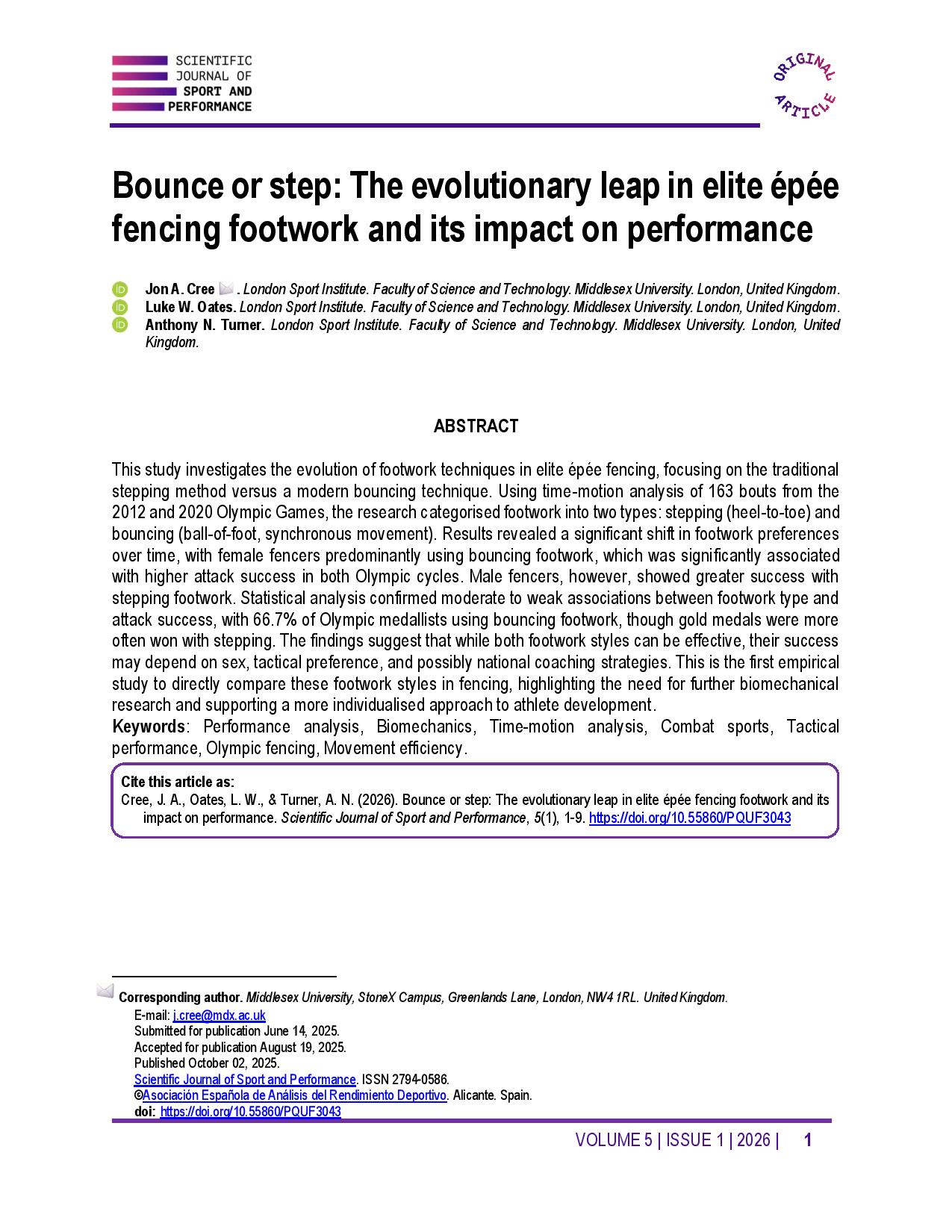Bounce or step The evolutionary leap in elite épée fencing footwork and its impact on performance
Main Article Content
Abstract
This study investigates the evolution of footwork techniques in elite épée fencing, focusing on the traditional stepping method versus a modern bouncing technique. Using time-motion analysis of 163 bouts from the 2012 and 2020 Olympic Games, the research categorised footwork into two types: stepping (heel-to-toe) and bouncing (ball-of-foot, synchronous movement). Results revealed a significant shift in footwork preferences over time, with female fencers predominantly using bouncing footwork, which was significantly associated with higher attack success in both Olympic cycles. Male fencers, however, showed greater success with stepping footwork. Statistical analysis confirmed moderate to weak associations between footwork type and attack success, with 66.7% of Olympic medallists using bouncing footwork, though gold medals were more often won with stepping. The findings suggest that while both footwork styles can be effective, their success may depend on sex, tactical preference, and possibly national coaching strategies. This is the first empirical study to directly compare these footwork styles in fencing, highlighting the need for further biomechanical research and supporting a more individualised approach to athlete development.
Article Details

This work is licensed under a Creative Commons Attribution-NonCommercial-ShareAlike 4.0 International License.
References
Bottoms, L., Greenhalgh, A., & Sinclair, J. (2013). Kinematic determinants of weapon velocity during the fencing lunge in experienced épée fencers. Acta of Bioengineering and Biomechanics, 15(4), 109-113.
Caron, K. E., Burr, J. F., & Power, G. A. (2020). The effect of a stretch-shortening cycle on muscle activation and muscle oxygen consumption: A study of history-dependence. The Journal of Strength & Conditioning Research, 34(11), 3139-3148. https://doi.org/10.1519/JSC.0000000000003815 DOI: https://doi.org/10.1519/JSC.0000000000003815
Dedieu, P., Salesse, M., Champain, G., & Zanone, P. (2024). Comparing lunge techniques depending on the weapon used: Differences between foil and epee fencers.24(4). https://doi.org/10.7752/jpes.2024.04111 DOI: https://doi.org/10.7752/jpes.2024.04111
Evangelista, N. (1996). The art and science of fencing McGraw-Hill.
Filipas, L., Bonato, M., Maggio, A., Gallo, G., & Codella, R. (2023). Effects of plyometric training on different 8‐week training intensity distributions in well‐trained endurance runners. Scandinavian Journal of Medicine & Science in Sports, 33(3), 200-212. https://doi.org/10.1111/sms.14257 DOI: https://doi.org/10.1111/sms.14257
Gaugler, W. M., & Nadi, A. (1997). The science of fencing: A comprehensive training manual for master and student: Including lesson plans for foil, sabre and epee instruction Laureate Press,U.S.
Harmenberg, J, Väggö, B & Schmitt, A. (2015). Epee 2.5. the new fencing paradigm revised and expanded with new contributions from three world champions (1st ed.). New York: SKA SwordPlay Books.
Lee, J., & Park, I. (2022). Effects of stepping-in-place tempo and type of roundhouse kick on coincidence-anticipation timing in taekwondo. International Journal of Performance Analysis in Sport, 22(2), 209-224. https://doi.org/10.1080/24748668.2022.2037984 DOI: https://doi.org/10.1080/24748668.2022.2037984
Lee, J., & Song, Y. (2020). The effects of stepping in place tempo and roundhouse kick types on response time in taekwondo. Journal of the Korean Applied Science and Technology, 37(4), 870-877.
Margaritopoulos, S., Theodorou, A., Methenitis, S., Zaras, N., Donti, O., & Tsolakis, C. (2015). The effect of plyometric exercises on repeated strength and power performance in elite karate athletes. Journal of Physical Education and Sport, 15(2), 310.
Oates, L. W., Campbell, I. G., Iglesias, X., Price, M. J., Muniz-Pumares, D., & Bottoms, L. M. (2019). The physiological demands of elite epée fencers during competition. International Journal of Performance Analysis in Sport, 19(1), 76. https://doi.org/10.1080/24748668.2018.1563858 DOI: https://doi.org/10.1080/24748668.2018.1563858
Swatowska, M., Akbas, A., & Juras, G. (2020). Injuries in high-performance fencers-a review. Archives of Budo, 16, 261-269.
Tataran, A., Teodorescu, S., Baltag, O. M., & Apostu, M. (2023). Study regarding the importance of monitoring physiological parameters in elite fencing. Studia Universitatis Babeș-Bolyai Educatio Artis Gymnasticae, 13-22. https://doi.org/10.24193/subbeag.68(1).02 DOI: https://doi.org/10.24193/subbeag.68(1).02
Thompson, K., Chang, G., Alaia, M., Jazrawi, L., & Gonzalez-Lomas, G. (2022). Lower extremity injuries in US national fencing team members and US fencing olympians. The Physician and Sportsmedicine, 50(3), 212-217. https://doi.org/10.1080/00913847.2021.1895693 DOI: https://doi.org/10.1080/00913847.2021.1895693
Turner, A. N., & Harmenberg, J. (2018). Why fencers should bounce: A new method of movement to engage the stretch-shortening cycle. International Journal of Sports Science & Coaching, 13(3), 452-460. https://doi.org/10.1177/1747954117747133 DOI: https://doi.org/10.1177/1747954117747133
Turner, A. N., James, N., Dimitriou, L., Greenhalgh, A., Moody, J., Fulcher, D., et al. (2014). Determinants of olympic fencing performance and implications for strength and conditioning training. The Journal of Strength & Conditioning Research, 28(10), 3001-3011. https://doi.org/10.1519/JSC.0000000000000478 DOI: https://doi.org/10.1519/JSC.0000000000000478
Turner, A. N., Marshall, G., Noto, A., Chavda, S., Atlay, N., & Kirby, D. (2017). Staying out of range: Increasing attacking distance in fencing. International Journal of Sports Physiology and Performance, 12(10), 1319-1323. https://doi.org/10.1123/ijspp.2016-0680 DOI: https://doi.org/10.1123/ijspp.2016-0680
Uthoff, A., Lenetsky, S., Reale, R., Falkenberg, F., Pratt, G., Amasinger, D., et al. (2023). A review of striking force in full-contact combat sport athletes: Effects of different types of strength and conditioning training and practical recommendations. Strength & Conditioning Journal, 45(1), 67-82. https://doi.org/10.1519/SSC.0000000000000705 DOI: https://doi.org/10.1519/SSC.0000000000000705




